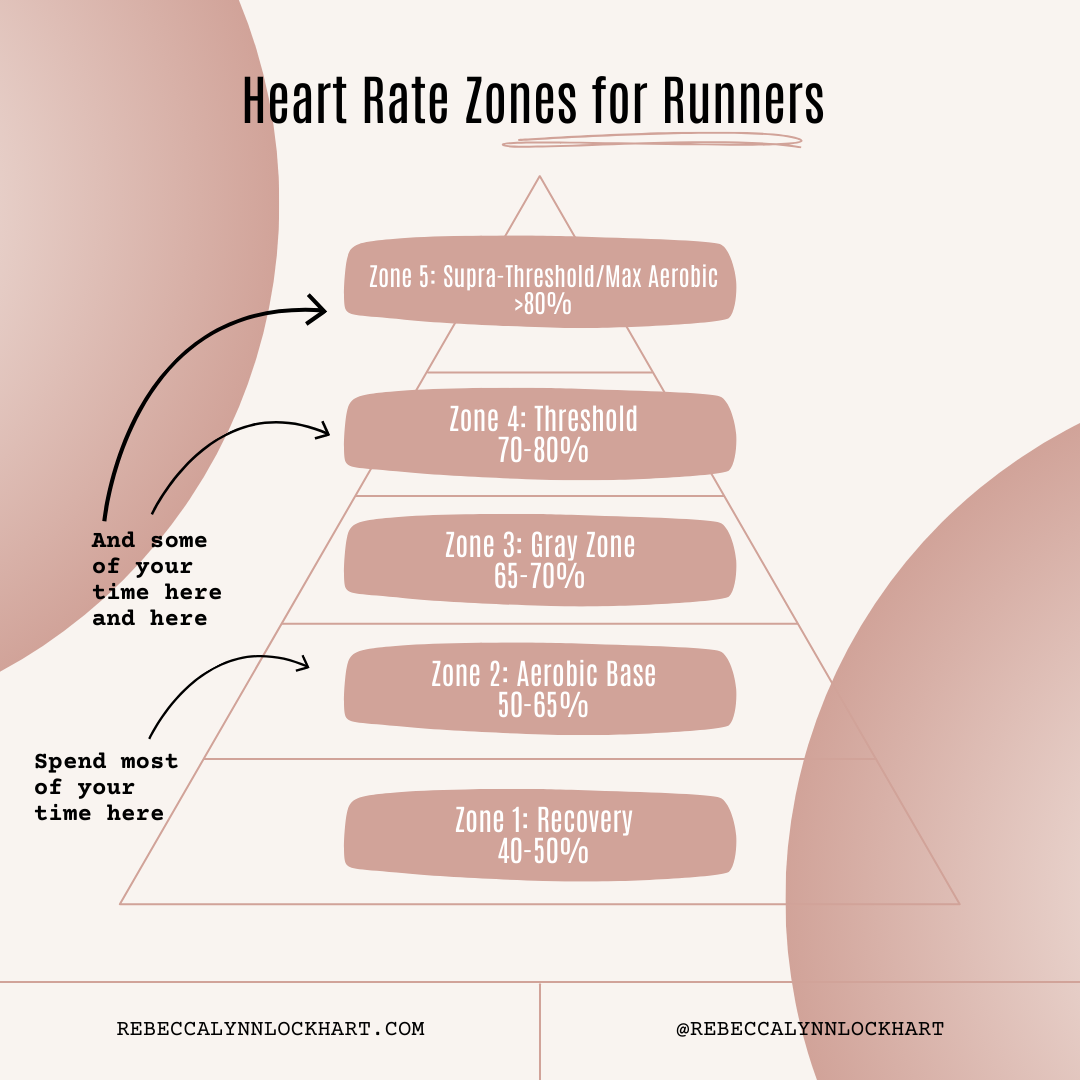Have you heard of the gray zone in running?
If you’ve read some of my other blog posts like the one I just put out about polarized training, you might be familiar with the term. Let’s go a bit more in depth today about what the gray zone is and why it’s not great to hang out there all the time.
The gray zone is equivalent to a runners Zone 3 heart rate zone. Zone 3 is an aerobic zone that has a small lactate response. This means that it’s not hard enough to elicit any kind of upper aerobic capacity response, like increasing your VO2 Max or your Lactate Threshold, but it’s too hard to properly recover from day in and day out. So really, there’s not much benefit in hanging out in this zone.
Many runners believe that the more hard runs they do, the faster the results. But this isn’t true. Spending the majority of your time in Zone 2 as an endurance athlete is key to long-term results. One study showed that total training time spent at low intensities might be associated with improved performance during highly intense endurance events, especially if the event duration is ~35 minutes.
Source: Esteve-Lanao, Jonathan, et al. “How do endurance runners actually train? Relationship with competition performance.” Medicine & Science in Sports & Exercise 37.3 (2005): 496-504.
The Magic of Zone 2
Zone 2 is a truly aerobic effort meaning there’s no lactate component. It’s easy. It SHOULD feel easy. You should be able to hold a conversation while running at this pace.
Zone 2 running does a few things:
- Elicits a recovery response
- Increases overall aerobic capacity
- Improves efficiency at using fat for energy
Keep your easy days easy and your hard days hard. If you’re a runner, you’ve likely heard this before. Easy days should be truly easy and running in zone 2 is going to keep it easy enough to elicit a recovery response in your body. Your body goes oh, this isn’t hard, I can relax and focus my efforts on recovery.
Running in Zone 2 is also going to increase your overall aerobic capacity. Think of your aerobic system has a car engine. The bigger the engine, the longer the vehicle can run. As endurance athletes, we want a BIG engine. Running in Zone 2 will increase that aerobic capacity so we can go faster longer.
And lastly running in Zone 2 will improve your body’s efficiency at using fat for energy. Because Zone 2 is truly an aerobic zone, it doesn’t need to be processing as many carbs. At higher levels of intensity, our body requires more energy. Carbs are a much faster and easier source of energy for your body. So when the intensity is high, your body is going to go for the easiest fuel source. But because Zone 2 is easy, it will increase your usage of fatty acids. If we can teach our bodies to use more fat for fuel, we will ultimately be able to run longer without hitting the wall. This is super important for endurance athletes.
How to Find Zone 2
If you Google how to create your heart rate zones, you’ll find a standard equation for your maximum heart rate (220-age) and then percentages to break down each zone.
The problem with this is that it doesn’t take into account your current level of fitness. My maximum heart rate is much higher than the 220-age equation tells me because of my current aerobic fitness levels.
Not everyone will have access to take a true max heart rate test or even have the physical capability. It is HARD to truly get to your max heart rate. Your body literally does not want to be there.
But there are some other tests you can do at home to get a better picture of your zones. The first would be a lactate threshold test which is pretty easy to do on your own. You can use the talk test method by starting at an easy pace, running for 2 minutes and then trying to say a chosen phrase out loud. When you get to a point where you can say your phrase, but you couldn’t say much more than that, you’ve hit your lactate threshold. Record your pace and your time. Your lactate threshold is about 70-80% of your maximum heart rate.
So while this isn’t perfect, it can at least give you a good starting point to build out your heart rate zones.
Note: If you hire me as your coach, we’ll do an additional test called an MLSS so we can get these a little more accurate.
Here is a general rule of thumb chart for heart rate zones. There are a bunch of different ways you can break up heart rate zones so if you see charts showing Zone 1A/1B, etc. know that it works and is just a way to break things down more minutely. I wanted to keep it as simple as I could for you guys trying to calculate this on your own.

If all this talk of math is hurting your head, no worries. Your Zone 2 is going to be an effort where you could hold a conversation pretty easily. On a rating of perceived exertion scale (RPE), you would be at a 3-4.
Remember that these runs should feel truly easy! Be honest with yourself. Your easy effort pace will be different day to day, week to week. This is because there are a myriad of factors that affect easy effort – nutrition, sleep, stress, weather, etc. So while a heart rate monitor can help, it shouldn’t be what you solely depend on for a definition of easy effort. Learning how to feel that easy effort is ultimately going to be the best way to go.
Remember: this post is for informational purposes only and may not be the best fit for you and your personal situation. It shall not be construed as medical advice. The information and education provided here is not intended or implied to supplement or replace professional medical treatment, advice, and/or diagnosis. Always check with your own physician or medical professional before trying or implementing any information read here.
Want more accurate heart rate zones?
Let’s set up a call! Click below and schedule your free consultation!

0 Comments